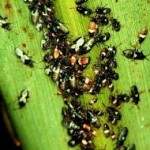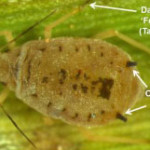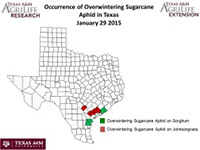By Robert Bowling (robert.bowling@ag.tamu.edu)
 CORN: Much of the 2015 south Texas corn crop is planted and has emerged. Abundant fall and winter rain has filled soil moisture profiles and the prospects are high for an above average corn crop. Monitoring insect pests is critical to avoid bumps that could derail production goals. Early season pests that may interfere with normal early-season plant development include cutworms, flea beetles, and chinch bugs.
CORN: Much of the 2015 south Texas corn crop is planted and has emerged. Abundant fall and winter rain has filled soil moisture profiles and the prospects are high for an above average corn crop. Monitoring insect pests is critical to avoid bumps that could derail production goals. Early season pests that may interfere with normal early-season plant development include cutworms, flea beetles, and chinch bugs.
 Cutworms: Several moth species commonly known as cutworms can be severe pests of corn. The larval or immature stages are smooth and colored dingy to grayish-black. Cutworms are active at night and damage corn by cutting the stalk just above ground level. Large cutworm populations may be found in grassy or weedy areas. Most cutworm species hide below the soil close to plant stalks during the day. Some Bt corn products, such as SmartStax®, and Powercore™, Optimum® Intrasect®, provide good to very good suppression of black cutworm. Insecticide seed treatments may be inconsistent and their performance against cutworms. Monitor all corn for cutworm damage through the 5th leaf stage. When cutworms are damaging plant stands, an application of insecticide by ground will usually provide adequate control. Best results are obtained when insecticides are applied in the late afternoon. Dry, cloddy, or crusty soils at time of treatment may have a negative impact on insecticide performance against cutworm.
Cutworms: Several moth species commonly known as cutworms can be severe pests of corn. The larval or immature stages are smooth and colored dingy to grayish-black. Cutworms are active at night and damage corn by cutting the stalk just above ground level. Large cutworm populations may be found in grassy or weedy areas. Most cutworm species hide below the soil close to plant stalks during the day. Some Bt corn products, such as SmartStax®, and Powercore™, Optimum® Intrasect®, provide good to very good suppression of black cutworm. Insecticide seed treatments may be inconsistent and their performance against cutworms. Monitor all corn for cutworm damage through the 5th leaf stage. When cutworms are damaging plant stands, an application of insecticide by ground will usually provide adequate control. Best results are obtained when insecticides are applied in the late afternoon. Dry, cloddy, or crusty soils at time of treatment may have a negative impact on insecticide performance against cutworm.
Chinch Bugs: Adult chinch bugs are black with whitish wings and approximately 1/6” to 1/8” long with black bodies and reddish-yellow legs. When fully developed, the white wings are marked with a triangular black spot near the middle of the back on the outer wing margin. Immature chinch bugs are reddish to blackish with a white band across the middle of the back. Adult and immature chinch bugs suck plant juices and cause reddening of the leaves. Large numbers of chinch bugs can move into a cornfield by crawling or flying from wild bunch grasses or small grains. Once in the field they congregate and feed b ehind the leaf sheaths of the corn plant and below the ground line on plant roots and crowns. Damage by chinch bugs normally occurs from seedling emergence until the plants are 18 inches tall. Stressed plants wilt and die from prolonged feeding. Damage is usually confined to the outside few rows. However, when chinch bugs are abundant, field-wide infestations may develop.
ehind the leaf sheaths of the corn plant and below the ground line on plant roots and crowns. Damage by chinch bugs normally occurs from seedling emergence until the plants are 18 inches tall. Stressed plants wilt and die from prolonged feeding. Damage is usually confined to the outside few rows. However, when chinch bugs are abundant, field-wide infestations may develop.
In fields with a history of early-season, eco¬nomically damaging chinch bug populations (see map for typical locations), the use of at-plant soil-incorporated insecticides can suppress the devel¬opment of chinch bug populations. Granular for¬mulations may provide 2 to 3 weeks of protection, provided sufficient rainfall is received following application to wash the insecticide off the gran¬ules. Young plants should be closely monitored for chinch bugs and feeding damage after germination and particularly during dry periods, even when at -plant insecticides are used. Make at least five random checks in the field. Insecticide should be applied when two or more adult chinch bugs are found on 20 percent of the seedlings less than 6 inches high. On taller plants apply insecticides when immature and adult bugs are found on 75 percent of the plants.
-plant insecticides are used. Make at least five random checks in the field. Insecticide should be applied when two or more adult chinch bugs are found on 20 percent of the seedlings less than 6 inches high. On taller plants apply insecticides when immature and adult bugs are found on 75 percent of the plants.
Sorghum: The sugarcane aphid has garnered much attention by Texas sorghum producers since it was found damaging fields in 2013. In 2014 the aphid spread throughout south Texas sorghum production fields and into the northern Texas Panhandle by October. It is hard to say what the aphid will do in 2015 but my best guess is that we should expect much of the same from it as in the previous two years.
Typically, the aphid is found in colonies on the underside of the lower leaves. Overwintering aphids may move to the base of live plants during cold environmental conditions. Morphological  characteristics important for sugarcane aphid identification include the dark cornicles (‘tail pipes’) and dark tarsi (‘feet) (see picture to the left). Hosts include any sorghum species including grain sorghum, forage sorghum, sudangrass and haygrazer. The aphid needs a live host to overwinter and can be found on any volunteer sorghum or johnsongrass.
characteristics important for sugarcane aphid identification include the dark cornicles (‘tail pipes’) and dark tarsi (‘feet) (see picture to the left). Hosts include any sorghum species including grain sorghum, forage sorghum, sudangrass and haygrazer. The aphid needs a live host to overwinter and can be found on any volunteer sorghum or johnsongrass.
Thus far the aphid has been observed overwintering as far north as Matagorda and Wilson counties (see map).  The image to the right shows overwintering sugarcane aphid on johnsongrass in Wils
The image to the right shows overwintering sugarcane aphid on johnsongrass in Wils on County.To date overwintering colonies have been comprised of wingless adult and nymphs (immature) aphids. Absence of winged adult sugarcane aphids suggests that flights to other areas are not imminent. Efforts will continue to track the aphid throughout the winter and into spring and producers will be alerted when winged adults are observed in the field. Look for updates on overwintering aphid populations and aphid movement as the season progresses.
on County.To date overwintering colonies have been comprised of wingless adult and nymphs (immature) aphids. Absence of winged adult sugarcane aphids suggests that flights to other areas are not imminent. Efforts will continue to track the aphid throughout the winter and into spring and producers will be alerted when winged adults are observed in the field. Look for updates on overwintering aphid populations and aphid movement as the season progresses.
This year two insecticides have been approved for use on sugarcane aphid in sorghum. Sivanto® received registration from the EPA and this product. Numerous efficacy studies have revealed that Sivanto provides excellent sugarcane aphid control in sorghum when used at Section 2ee labeled rates of 4 to 7 oz/ac. Bayer CropScience indicates that this product is compatible with many beneficial insects and predatory mites. Sivanto has a preharvest interval (PHI) of 21 days for dried grain, stover or straw, and 7 days for forage. The EPA granted a Section 18 on Transform for Texas. This Section 18 runs through October 31 and allows for two in-season applications of Transform for sugarcane aphid in sorghum. Labeled rates range from 0.75 to 1.5 oz/ac. The Section 18 allows for two applications per acre per year and not to exceed 3 oz/ac. A higher rate range is recommended for heavy sugarcane aphid populations. This product has a 14 day PHI for grain or straw harvest and a 7 day PHI for grazing or forage, fodder, or hay harvest. Insecticide applications are suggested when sugarcane aphid densities average 50 to 125 aphids per leaf. Please monitor all sorghum fields (including forage sorghum, sudangrass, and haygrazer) carefully throughout the season as this aphid can builds its populations to high numbers in a very short period of time.
